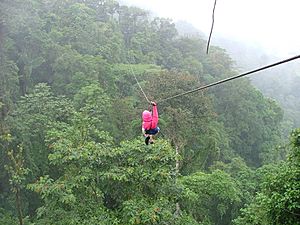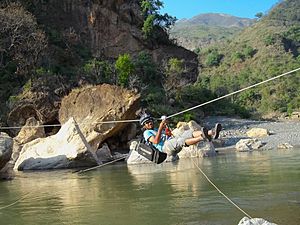Zip-line facts for kids
A zip-line is a fun way to slide down a wire or rope! It uses gravity to make you go fast. You can stop by dragging your feet or by using special brakes. Most zip-lines use a pulley that hangs from a strong cable, usually made of stainless steel.
Zip-lines are often used for exciting adventures. Some are short and low, perfect for kids on a playground. Others are super long and high, used to explore places like a rainforest or to cross a river.
How Zip-Lines Started
Zip-wires have been used for over 2,000 years in some mountainous areas. People in Europe, China, and the Himalayas used them to get around since the 1700s.
In the Australian outback, zip-lines sometimes helped deliver things like food or tools. They were great for people who needed to cross a tricky spot like a deep gully or a river. Australian soldiers even used them to move supplies quickly during wars.
During World War II, the United States Army started using zip-lines. They built tall towers with zip-lines to help train airborne forces. This helped soldiers practice landing safely, similar to a parachute jump. It was a big success and is still used today for training.
Costa Rica says it's where modern zip-line tours began. Two rock-climbers, John Williams and Donald Perry, were studying plants and insects there. They used their climbing gear to go up and down trees. Soon, other students started using the lines too. This led to the first fun zip-line tours for visitors in Costa Rica.

Fun Zip-Line Adventures
Zip-line tours are now very popular for vacations. Some are short, like 100 feet, while others can be as long as a mile!
Places like the jungles of Costa Rica, Florida, and Nicaragua are famous for their amazing zip-line experiences. Since 2000, there are over 200 zip-line tours in the United States alone. You can find them at places like Santa Catalina Island and the San Diego Zoo in California.
Prices for zip-line rides can change. For example, a ride at the San Diego Zoo might cost $112 for two lines. At the Santa Paula, California KOA, an 800-foot zip-line costs about $10. In Durango, Colorado, you can find a tour with 27 zip-lines that are about 1.5 miles long in total! This adventure can last for five hours.
In Sun City, South Africa, the Zip 2000 is one of the longest zip-lines in the world, stretching over 1 mile! The "Miss Sky Canopy Tour" in Nosara, Costa Rica, is the world's longest zip-line tour. It's about 7 miles long and has 21 different sections. Taihape, New Zealand has some of the fastest zip-lines, sometimes called "flying foxes," where you can reach speeds over 100 miles per hour!
Images for kids
-
Zip-line in Hemlock Overlook rope course.
-
Hocking Peaks Adventure Park, Logan, Ohio.
-
Departure zip SuperFly in Whistler, British Columbia, Canada.
See also
 In Spanish: Tirolesa para niños
In Spanish: Tirolesa para niños








